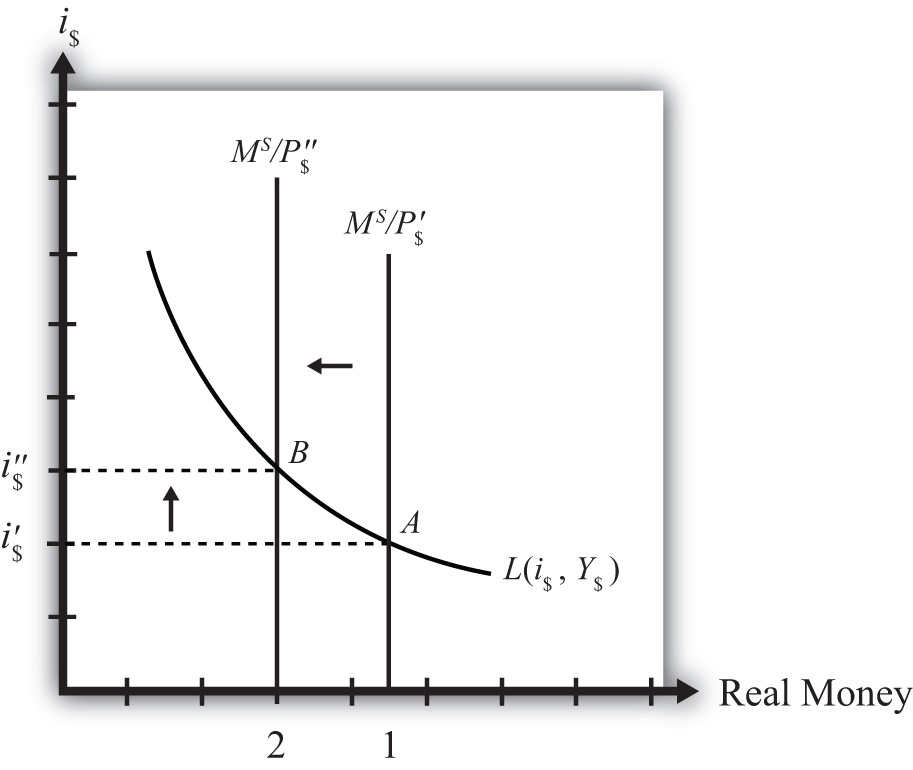1. Explain How An Increase In The Price Level Affects The Real Value Of Money?
18.ten Effect of a Price Level Increment (Inflation) on Involvement Rates
Learning Objective
- Acquire how a change in the cost level affects the equilibrium interest rate.
At present let'south consider the effects of a price level increase in the money market place. When the price level rises in an economy, the average price of all goods and services sold is increasing. Inflation is calculated as the percentage increase in a country's toll level over some menses, usually a year. This means that in the period during which the price level increases, aggrandizement is occurring. Thus studying the effects of a toll level increment is the same every bit studying the effects of inflation.
Aggrandizement can arise for several reasons that will exist discussed later in this chapter. For at present, we will imagine that the toll level increases for some unspecified reason and consider the consequences.
Suppose the money market is originally in equilibrium at point A in Figure 18.4 "Effects of a Toll Level Increment" with existent money supply M S /P $′ and interest rate i $′. Suppose the price level increases, ceteris paribus. Again, the ceteris paribus assumption means that we assume all other exogenous variables in the model remain stock-still at their original levels. In this exercise, it means that the money supply (K S ) and real Gdp (Y $) remain fixed. An increment in the price level (P $) causes a decrease in the real coin supply (M S /P $) since M South remains constant. In the adjoining diagram, this is shown every bit a shift from Grand South /P $′ to Grand S /P $″. At the original interest rate, i $′, the real coin supply has fallen to level ii along the horizontal centrality, while real money demand remains at level 1. This means that money demand exceeds money supply and the actual interest rate is lower than the new equilibrium rate. Adjustment to the higher interest rate volition follow the "involvement rate too low" equilibrium story.
Figure 18.iv Effects of a Toll Level Increment

More than intuition apropos these effects arises if ane recalls that price level increases will increase the transactions demand for money. In this version, nominal coin demand volition exceed nominal money supply and set up off the same adjustment process described in the previous paragraph.
The final equilibrium will occur at betoken B on the diagram. The existent coin supply will have fallen from level ane to level 2 while the equilibrium involvement rate has risen from i $′ to i $″. Thus an increment in the price level (i.east., inflation) volition cause an increase in average interest rates in an economy. In contrast, a decrease in the cost level (deflation) volition cause a decrease in average interest rates in an economic system.
Key Takeaway
- An increase in the price level (i.e., inflation), ceteris paribus, will cause an increase in average interest rates in an economy. In contrast, a decrease in the cost level (deflation), ceteris paribus, will cause a decrease in boilerplate involvement rates in an economy.
Exercise
-
Jeopardy Questions. As in the popular tv game show, you are given an reply to a question and yous must answer with the question. For example, if the respond is "a taxation on imports," then the correct question is "What is a tariff?"
- The term used to describe a percentage increase in a country's price level over a flow of fourth dimension.
- Of increment, decrease, or stay the aforementioned, the effect on the equilibrium interest rate when the domestic toll level decreases, ceteris paribus.
- Of increase, subtract, or stay the same, the event on the equilibrium interest rate when the domestic price level increases, ceteris paribus.
Source: https://saylordotorg.github.io/text_international-economics-theory-and-policy/s21-10-effect-of-a-price-level-increa.html
Posted by: williamshemperess.blogspot.com

0 Response to "1. Explain How An Increase In The Price Level Affects The Real Value Of Money?"
Post a Comment